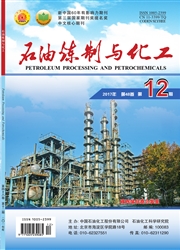

 中文摘要:
中文摘要:
以国内某延迟焦化装置作为研究对象,运用流程模拟软件PRO/Ⅱ对进料预热过程进行模拟分析。采用夹点分析策略,充分考虑焦化换热网络的特征,确定将工艺物流热量发生蒸汽和不发生蒸汽工况下进料的理论换热终温作为进料预热流程调整的目标温度。应用物流灵敏度分析的计算方法,定量构建原料预热过程的能级-热量(ε-Q)图,通过过程炯损计算,发现预热过程的用能“瓶颈”在于混合和大温差换热炯损。按照“温度对口,梯级利用”的原则,对进料预热过程进行优化调整。实例研究表明,进料预热流程调整后,冷、热进料的混合[火用]损下降80%,进料预热过程单位温升的换热炯损下降24.1%,且换热终温提高43℃,减少了加热炉负荷约4.2MW,节能效果明显。
 英文摘要:
英文摘要:
Taking a delayed coking unit (DCU) in a domestic refinery as the research object, the feed preheating process was simulated by PRO/Ⅱ, the process simulation software. Considering the trait of the heat exchange network for DCU, the strategy of pinch analysis was introduced to calculate the highest theoretical heat exchange temperature for the feed, taken as the target temperature for the retro- fit of the feed preheating process. In a case study, the quantitative energy grade and heat duty (e-Q) dia- gram was constructed. By calculating the exergy destructions, it is found that the "bottleneck" of the preheating process is exergy destructions from mixing and heat exchange processes with large tempera- ture differences. According to the principle of "counterpart temperature, cascade using", the feed pre- heating process was retrofitted. The case study results show that the exergy destruction of mixing process is decreased by 80% and the exergy destruction of heat exchange process for preheating the feeds per 1℃ increase is decreased by 24. 1% after the retrofit. Meanwhile, the final heat exchange tempera- ture of feed is increased by 43 ℃. The heat duty of the coking furnace is decreased by 4.2 MW, which indicates that the effect for energy saving is obvious.
 关于齐鑫:
关于齐鑫:
 关于陈清林:
关于陈清林:
 关于张冰剑:
关于张冰剑:
 同期刊论文项目
同期刊论文项目
 同项目期刊论文
同项目期刊论文
 A reactive distillation process with a sidedraw stream to enhance the production of isopropyl acetat
A reactive distillation process with a sidedraw stream to enhance the production of isopropyl acetat A hydraulics-based heuristic strategy for capacity expansion retrofit of distillation systems and an
A hydraulics-based heuristic strategy for capacity expansion retrofit of distillation systems and an 期刊信息
期刊信息
